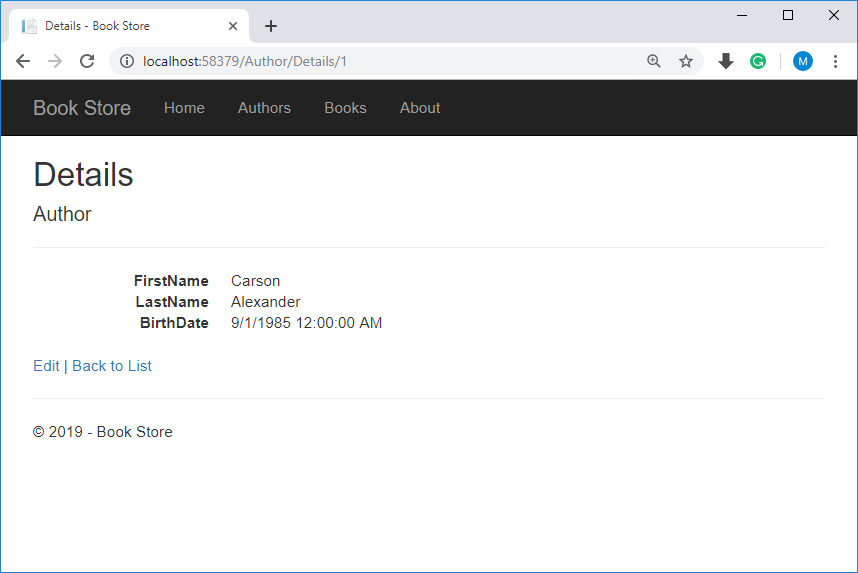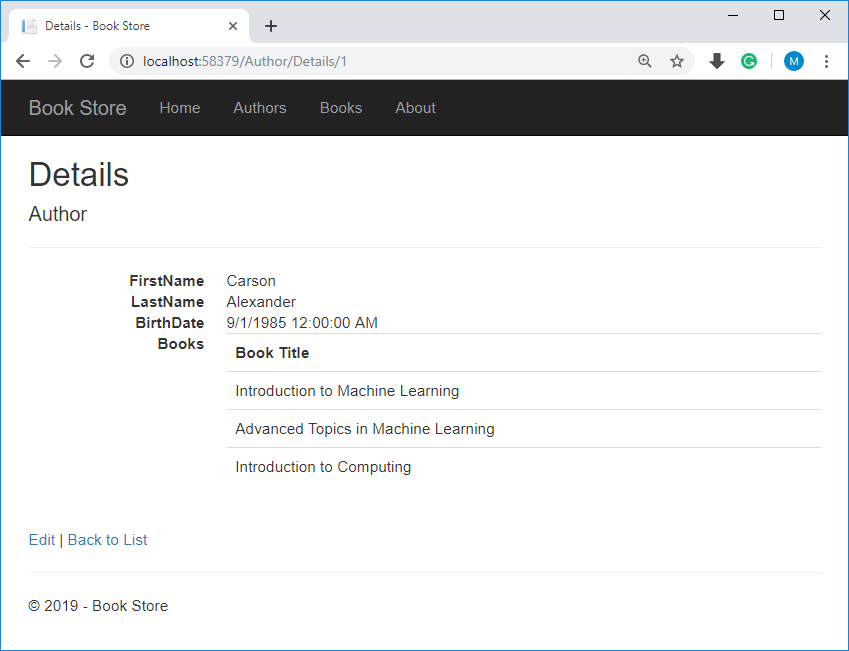EF 6 + MVC Basic CRUD Functionality
In this article, we will customize the create, read, update, delete (CRUD) code that the MVC scaffolding automatically creates for you in controllers and views. Let's run your application.

In Details method, the key value is passed to the method as the id parameter and comes from route data in the Details hyperlink on the Index page.
You can create new author, delete or edit an author, and you can also see the details of any particular author using the highlighted links. Let's click on Edit link and you only see the author's name.

Details View
If you open the AuthorController you will see Details action method.
// GET: Author/Details/5
public ActionResult Details(int? id)
{
if (id == null)
{
return new HttpStatusCodeResult(HttpStatusCode.BadRequest);
}
Author author = db.Authors.Find(id);
if (author == null)
{
return HttpNotFound();
}
return View(author);
}
The scaffolded code for the author Details page left out the Books property because that property holds a collection and this is not displayed on Details.cshtml file.
@model MvcWithEF6Demo.Models.Author
@{
ViewBag.Title = "Details";
}
<h2>Details</h2>
<div>
<h4>Author</h4>
<hr />
<dl class="dl-horizontal">
<dt>
@Html.DisplayNameFor(model => model.FirstName)
</dt>
<dd>
@Html.DisplayFor(model => model.FirstName)
</dd>
<dt>
@Html.DisplayNameFor(model => model.LastName)
</dt>
<dd>
@Html.DisplayFor(model => model.LastName)
</dd>
<dt>
@Html.DisplayNameFor(model => model.BirthDate)
</dt>
<dd>
@Html.DisplayFor(model => model.BirthDate)
</dd>
</dl>
</div>
<p>
@Html.ActionLink("Edit", "Edit", new { id = Model.AuthorId }) |
@Html.ActionLink("Back to List", "Index")
</p>
Each field is displayed using a DisplayFor helper, so here we will display the contents of the collection in an HTML table as shown below.
@model MvcWithEF6Demo.Models.Author
@{
ViewBag.Title = "Details";
}
<h2>Details</h2>
<div>
<h4>Author</h4>
<hr />
<dl class="dl-horizontal">
<dt>
@Html.DisplayNameFor(model => model.FirstName)
</dt>
<dd>
@Html.DisplayFor(model => model.FirstName)
</dd>
<dt>
@Html.DisplayNameFor(model => model.LastName)
</dt>
<dd>
@Html.DisplayFor(model => model.LastName)
</dd>
<dt>
@Html.DisplayNameFor(model => model.BirthDate)
</dt>
<dd>
@Html.DisplayFor(model => model.BirthDate)
</dd>
<dt>
@Html.DisplayNameFor(model => model.Books)
</dt>
<dd>
<table class="table">
<tr>
<th>Book Title</th>
</tr>
@foreach (var item in Model.Books)
{
<tr>
<td>
@Html.DisplayFor(modelItem => item.Title)
</td>
</tr>
}
</table>
</dd>
</dl>
</div>
<p>
@Html.ActionLink("Edit", "Edit", new { id = Model.AuthorId }) |
@Html.ActionLink("Back to List", "Index")
</p>
Now run your application and go to the details page.

Create View
In AuthorController, you will see Create action method.
[HttpPost]
[ValidateAntiForgeryToken]
public ActionResult Create([Bind(Include = "AuthorId,FirstName,LastName,BirthDate")] Author author)
{
if (ModelState.IsValid)
{
db.Authors.Add(author);
db.SaveChanges();
return RedirectToAction("Index");
}
return View(author);
}
- This code adds the
Authorentity created by the ASP.NET MVC model binder to theAuthorsentity set and then saves the changes to the database. - Model binder refers to the ASP.NET MVC functionality that makes it easier for you to work with data submitted by a form.
- A model binder converts posted form values to CLR types and passes them to the action method in parameters.
- In this case, the model binder instantiates an
Authorentity for you using property values from the Form collection.
Let's update Create action method adding a try-catch block.
[HttpPost]
[ValidateAntiForgeryToken]
public ActionResult Create([Bind(Include = "AuthorId,FirstName,LastName,BirthDate")] Author author)
{
try
{
if (ModelState.IsValid)
{
db.Authors.Add(author);
db.SaveChanges();
return RedirectToAction("Index");
}
}
catch (DataException)
{
ModelState.AddModelError("", "Unable to save changes. Try again, and if the problem persists see your system administrator.");
}
return View(author);
}
The code in Views\Author\Create.cshtml is similar to what we saw in Details.cshtml, except that EditorFor and ValidationMessageFor helpers are used for each field instead of DisplayFor.
@model MvcWithEF6Demo.Models.Author
@{
ViewBag.Title = "Create";
}
<h2>Create</h2>
@using (Html.BeginForm())
{
@Html.AntiForgeryToken()
<div class="form-horizontal">
<h4>Author</h4>
<hr />
@Html.ValidationSummary(true, "", new { @class = "text-danger" })
<div class="form-group">
@Html.LabelFor(model => model.FirstName, htmlAttributes: new { @class = "control-label col-md-2" })
<div class="col-md-10">
@Html.EditorFor(model => model.FirstName, new { htmlAttributes = new { @class = "form-control" } })
@Html.ValidationMessageFor(model => model.FirstName, "", new { @class = "text-danger" })
</div>
</div>
<div class="form-group">
@Html.LabelFor(model => model.LastName, htmlAttributes: new { @class = "control-label col-md-2" })
<div class="col-md-10">
@Html.EditorFor(model => model.LastName, new { htmlAttributes = new { @class = "form-control" } })
@Html.ValidationMessageFor(model => model.LastName, "", new { @class = "text-danger" })
</div>
</div>
<div class="form-group">
@Html.LabelFor(model => model.BirthDate, htmlAttributes: new { @class = "control-label col-md-2" })
<div class="col-md-10">
@Html.EditorFor(model => model.BirthDate, new { htmlAttributes = new { @class = "form-control" } })
@Html.ValidationMessageFor(model => model.BirthDate, "", new { @class = "text-danger" })
</div>
</div>
<div class="form-group">
<div class="col-md-offset-2 col-md-10">
<input type="submit" value="Create" class="btn btn-default" />
</div>
</div>
</div>
}
<div>
@Html.ActionLink("Back to List", "Index")
</div>
@section Scripts {
@Scripts.Render("~/bundles/jqueryval")
}
It also includes @Html.AntiForgeryToken(), which works with the ValidateAntiForgeryToken attribute in the controller to help prevent cross-site request forgery attacks.
Edit View
[HttpPost]
[ValidateAntiForgeryToken]
public ActionResult Edit([Bind(Include = "AuthorId,FirstName,LastName,BirthDate")] Author author)
{
if (ModelState.IsValid)
{
db.Entry(author).State = EntityState.Modified;
db.SaveChanges();
return RedirectToAction("Index");
}
return View(author);
}
- The scaffolder generated a
Bindattribute and added the entity created by the model binder to the entity set with aModifiedflag. - It is no longer recommended because the
Bindattribute clears out any pre-existing data in fields not listed in theIncludeparameter.
Let's implement a security best practice to prevent overposting by reading the existing entity and calls TryUpdateModel to update fields from user input in the posted form data.
[HttpPost, ActionName("Edit")]
[ValidateAntiForgeryToken]
public ActionResult EditPost(int? id)
{
var author = db.Authors.Find(id);
if (TryUpdateModel(author, "", new string[] { "FirstName", "LastName", "BirthDate" }))
{
try
{
db.SaveChanges();
return RedirectToAction("Index");
}
catch (DataException /* dex */)
{
//Log the error (uncomment dex variable name and add a line here to write a log.
ModelState.AddModelError("", "Unable to save changes. Try again, and if the problem persists, see your system administrator.");
}
}
return View(author);
}
- To prevent overposting, the fields that you want to be updateable by the Edit page are whitelisted in the
TryUpdateModelparameters. - The Entity Framework's automatic change tracking sets the
EntityState.Modifiedflag on the entity. - When the
SaveChangesmethod is called, theModifiedflag causes EF to create SQL statements to update the database row. - As a result of these changes, the method signature of the
HttpPostEdit method is the same as theHttpGetEdit method; therefore we have renamed the method toEditPost. - The HTML and Razor code in
Views\Author\Edit.cshtmlis similar to what you saw inCreate.cshtml, and no changes are required.
Delete View
In Controllers\AuthorController.cs, the template code for the HttpGet Delete method uses the Find method to retrieve the selected Author entity, as we saw in the Details and Edit methods.
- However, to implement a custom error message when the call to
SaveChangesfails, we will add some functionality to this method and its corresponding view. - The delete operations require two action methods.
// GET: Author/Delete/5
public ActionResult Delete(int? id)
{
if (id == null)
{
return new HttpStatusCodeResult(HttpStatusCode.BadRequest);
}
Author author = db.Authors.Find(id);
if (author == null)
{
return HttpNotFound();
}
return View(author);
}
// POST: Author/Delete/5
[HttpPost, ActionName("Delete")]
[ValidateAntiForgeryToken]
public ActionResult DeleteConfirmed(int id)
{
Author author = db.Authors.Find(id);
db.Authors.Remove(author);
db.SaveChanges();
return RedirectToAction("Index");
}
- The method that is called in response to a
GETrequest displays a view that gives the user a chance to approve or cancel the delete operation. - If the user approves it, a
POSTrequest is created, theHttpPost Delete(namedDeleteConfirmed) method is called and then that method actually performs the delete operation.
We will add a try-catch block to the DeleteConfirmed method to handle any errors that might occur when the database is updated and also change the method name to Delete. So let's replace the DeleteConfirmed method with the following code, which performs the actual delete operation and catches any database update errors.
// POST: Author/Delete/5
[HttpPost]
[ValidateAntiForgeryToken]
public ActionResult Delete(int id)
{
try
{
Author author = db.Authors.Find(id);
db.Authors.Remove(author);
db.SaveChanges();
}
catch (DataException/* dex */)
{
//Log the error (uncomment dex variable name and add a line here to write a log.
return RedirectToAction("Delete", new { id = id, saveChangesError = true });
}
return RedirectToAction("Index");
}
- If an error occurs, the
HttpPost Deletemethod calls theHttpGet Deletemethod, passing it a parameter that indicates that an error has occurred. - The
HttpGet Deletemethod then redisplays the confirmation page along with the error message, giving the user an opportunity to cancel or try again.
Let's replace the HttpGet Delete action method with the following code, which manages error reporting.
// GET: Author/Delete/5
public ActionResult Delete(int? id, bool? saveChangesError = false)
{
if (id == null)
{
return new HttpStatusCodeResult(HttpStatusCode.BadRequest);
}
if (saveChangesError.GetValueOrDefault())
{
ViewBag.ErrorMessage = "Delete failed. Try again, and if the problem persists see your system administrator.";
}
Author author = db.Authors.Find(id);
if (author == null)
{
return HttpNotFound();
}
return View(author);
}
- It retrieves the selected entity, then calls the
Removemethod to set the entity's status to Deleted. - When
SaveChangesis called, a SQLDELETEcommand is generated.
In Views\Author\Delete.cshtml, add an error message @ViewBag.ErrorMessage between the <h2> heading and the <h3> heading as shown below.
@model MvcWithEF6Demo.Models.Author
@{
ViewBag.Title = "Delete";
}
<h2>Delete</h2>
<p class="error">@ViewBag.ErrorMessage</p>
<h3>Are you sure you want to delete this?</h3>
<div>
<h4>Author</h4>
<hr />
<dl class="dl-horizontal">
<dt>
@Html.DisplayNameFor(model => model.FirstName)
</dt>
<dd>
@Html.DisplayFor(model => model.FirstName)
</dd>
<dt>
@Html.DisplayNameFor(model => model.LastName)
</dt>
<dd>
@Html.DisplayFor(model => model.LastName)
</dd>
<dt>
@Html.DisplayNameFor(model => model.BirthDate)
</dt>
<dd>
@Html.DisplayFor(model => model.BirthDate)
</dd>
</dl>
@using (Html.BeginForm()) {
@Html.AntiForgeryToken()
<div class="form-actions no-color">
<input type="submit" value="Delete" class="btn btn-default" /> |
@Html.ActionLink("Back to List", "Index")
</div>
}
</div>
